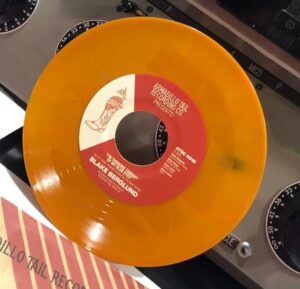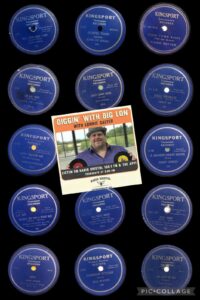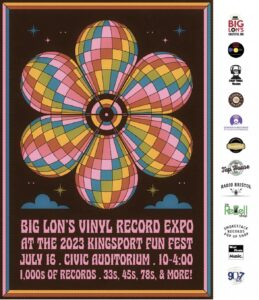Lonnie “Big Lon” Salyer is a vinyl record historian focused on local independent studios and labels in Southern Appalachia. His show “Diggin’ With Big Lon” airs weekly on WBCM Radio Bristol.
Hey ya’ll this is Big Lon checking in to make sure you are aware that August 12th is National Vinyl Record Day, a celebration of vinyl records, their history, and their significance in music and culture. If you’re interested in collecting vinyl records, here are some guidelines on what to collect, where to find them, and how to store and clean them.

First off there’s not a wrong answer on what to collect, it all depends on you and what makes you happy. Music provides both a connective social bond and an individual experience, and no two people have the same tastes or collective life journeys. Collecting vinyl records bridges both realms together in a tangible format you can hold in your hand. I’m still learning and certainly don’t know all the answers but here’s my two cents based on my collecting experience.
What should I collect Big Lon? I’d answer that with what do you like about music? What are your motivations when it comes to hobbies, investments, collecting, socializing? I can break this down into five basic categories to consider. First, what’s your personal connection with music? A great way to start is collecting records that have sentimental value to you on a personal level. Do you remember a song from Saturday morning cartoons or a song that you used to listen to with your grandfather on the drive to and from fishing trips? It may be as simple as the music you and your friends liked back in college or middle school. Make a list of all those songs you connect with as a bucket list you’d like to have on vinyl. Secondly, what genres of music and artists do you like? You can focus on records from your favorite artists or specific genres like heavy metal or even eras such as 1950’s jazz. This will be a great starting point that can lead to discovering similar artists or labels that specialize in the genre of music you like. Maybe you want to get into vinyl for the collectible aspect because you heard of valuable vinyl records and want to invest in records in hopes of your collection growing in value. Limited editions and limited pressings can fulfill this option. Limited releases, colored vinyl, and special editions can be valuable and unique additions to your collection. A great example is this limited pressing orange vinyl 45rpm release by Blake Berglund, recorded at The Earnest Tube in Bristol and released on Armadillo Tail Records.

Befriending the owners and sales people at your local vinyl record shop can lead to insight on when new releases will hit the shelves or what unique items your local shop will be getting for Record Store Day, which occurs annually in April. A fourth option is focusing on classic iconic albums that have had a significant impact on music history. A simple google search of the greatest or essential vinyl records in a genre you are interested in or maybe the top 20 of multiple genres so you can build a diverse interesting collection to match your mood or the social crowd you are having over for dinner or a cup of coffee. A final category I recommend is obscure and rare records. Once you get a little experience in vinyl collecting this one tends to happen organically. Seek out records that are hard to find or have historical significance. It can be that local band that you remember from high school that put out one independent record or whatever inspires you. For me, the hard-to-find Kingsport label from the 78rpm era of the early 1950s is one I actively collect.

Big Lon, where do I find vinyl records? We’ve already touched on visiting your local record shops to get an understanding of what they offer. Local record stores often have a diverse selection of vinyl records, both new and used. These stores can be a great place to discover hidden gems and interact with fellow enthusiasts. Online marketplaces like eBay, Discogs, and Amazon offer a wide range of vinyl records for sale. You can find rare and collectible records from various sellers. I’m a member of several Facebook groups of like interested collectors who specialize in specific record genres or format sizes such as LPs (33rpm), 78rpm or 45rpm. Flea markets and thrift stores are essential. Get to know those in your community. These spots can be treasure troves for vinyl collectors. You might stumble upon valuable records at affordable prices. In addition, don’t overlook estate sales and garage sales; occasionally, people sell off their vinyl collections, often at reasonable prices. I’ve personally bought four records that are valued over $1,000 each for a buck or less at rummage sales and from flea market dealers. Another great avenue is music festivals and conventions. Sometimes music events and conventions include vinyl vendors or the artists will have a merchandise table selling vinyl records along with t-shirts and swag. As you get your bearings in the hobby and a focused list of what you are looking for, I recommend record fairs. These events gather multiple sellers in one place, offering a variety of records for sale. It’s a great opportunity to network and learn more about collecting. I host one for Fun Fest in Kingsport, TN to meet new vinyl enthusiasts and network to find records on my want list.

How do I store vinyl records Big Lon? The key is vertical storage. Heavy flat stacks of LP’s and especially 78rpm records can cause damage. Store records vertically to distribute weight which helps prevent warping. Use record crates, shelves, or dedicated record storage units. Keep records in protective inner sleeves to prevent scratches and dust buildup. Outer sleeves can safeguard the album covers. For loose 45rpm or 78rpm records, your local record shop most likely carries packaged sleeves you can utilize to protect the vinyl. Climate control is a major priority. Direct sunlight can warp and damage the vinyl and fade the covers. A cool, dry environment is ideal. Extreme temperature and humidity fluctuations can warp records or cause labels and covers to mildew. I’ve run across records with mold growing in the grooves from dirt and debris in wrong storage climates, like records found in musty basements.
OK Big Lon, what if I find the perfect record but it’s not been well cared for, what do I do? Here are some tips for cleaning records: first, handle records correctly by their edges and avoid touching the playing surface with your fingers. This keeps the oils from your skin off the vinyl to avoid the collection of dust and dirt. Sometimes what’s perceived as scratches or skips can be resolved with a gentle cleaning of the grooves. Use a carbon fiber brush to remove dust and debris from the surface before playing. A microfiber cloth can help clean the album cover. Invest in a good cleaning solution or cleaning system. I personally use Pristine Platters and a microfiber cloth for light cleanings and a system called Spin Clean for more challenging cleans. Both products as well as several similar products can be found online or at a local record shop. A static roller can work wonders to remove pops and crackles associated with static energy build up. Some collectors come up with their own system for cleaning records. Research any household cleaners before you use them to make sure they don’t contain chemicals that can damage your vinyl collection. Dry your records including the labels before putting them back in the sleeves and before putting them on your turntable.
Collecting vinyl records can be a rewarding and enjoyable hobby. Remember that each collector’s journey is unique, so feel free to tailor your collection to your personal preferences and interests.
Happy collecting!
Local & Regional Record Stores
- Follow Big Lon’s record collecting journey at Big Lon’s Crateful Dig on Facebook or biglonscratefuldig.com
- Ceremonial Sound, Bristol, VA
- PD’s Records And Tapes, Kingsport, TN PDs Records And Tapes, on Facebook
- The ReCell Shop (aka Frank’s Vinyl Records), Bristol, TN
- Back Door Records, Johnson City, TN Back Door Record JC TN on Facebook
- Mr. K’s Used Books, Music And More, Johnson City, TN
- G2K Records, Norton, VA G2K Records on Facebook
Resources
Example Record Collecting Facebook groups


